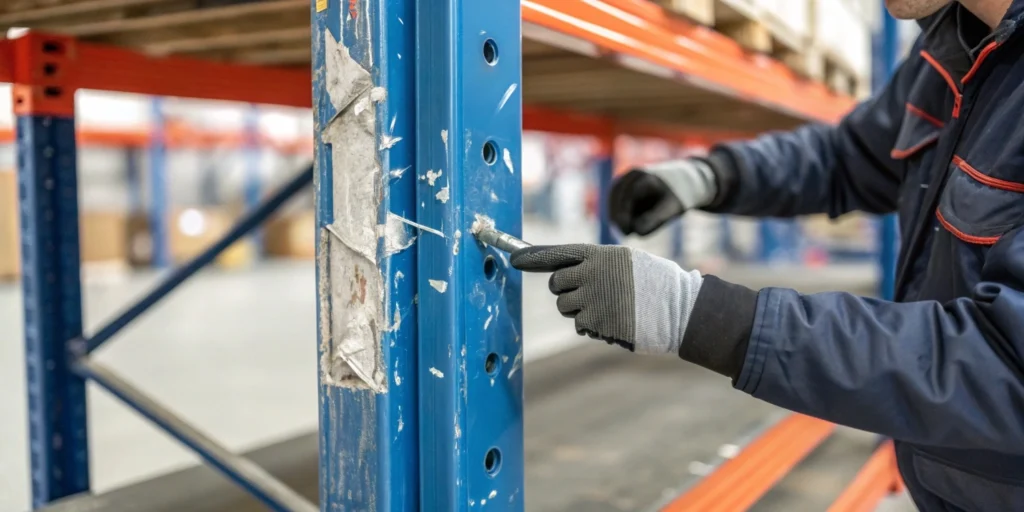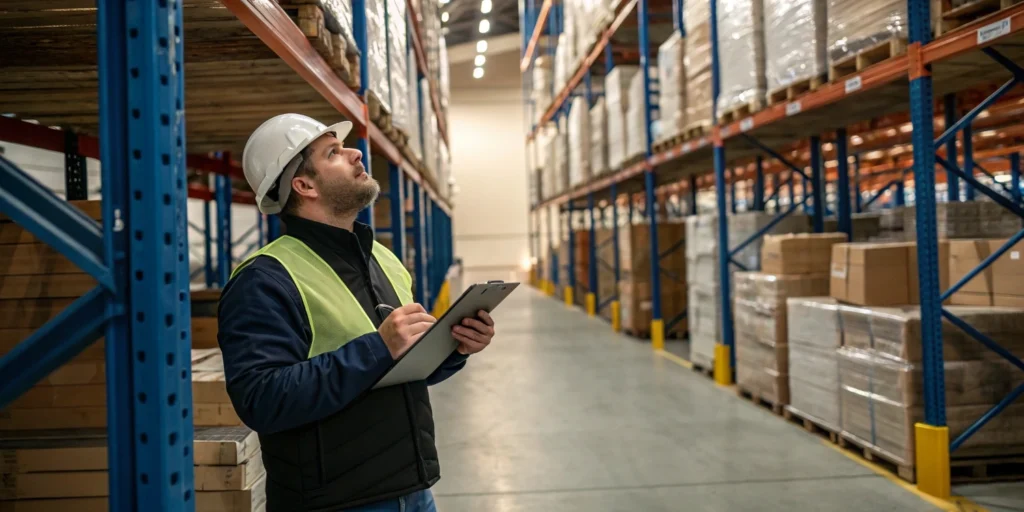
Table of Contents
Pallet racks are a vital component in maintaining order and stability within your warehouse operations. They keep your inventory in order, ensure efficient operations, and maintain a safe workspace. But when damage occurs—and it will—your response needs to be fast, informed, and precise. Delayed or improper repair doesn’t just impact workflow; it risks injury, product loss, and non-compliance with safety standards. If you’re managing a facility, your ability to handle rack damage swiftly can mean the difference between business as usual and costly downtime.
This guide delivers five effective tips to help you handle pallet rack repair with confidence and minimal disruption.
Tip #1 – Perform Frequent Inspections to Catch Damage Early
Spotting issues early is the most effective way to prevent major rack failures. It’s wise to intervene before any visible structural compromise appears. By integrating scheduled inspections into your maintenance routine, you’ll identify issues before they become expensive emergencies.

What You Should Focus On:
- Uprights and beams: Check for dents, cracks, and rust
- Footplates and anchors: Ensure they are firmly secured
- Bracing and weld points: Look for bending or metal fatigue
- Safety clips or pins: Make sure all components are in place
How Often Should You Inspect?
| Warehouse Type | Inspection Frequency |
| High traffic (daily ops) | Monthly |
| Standard usage | Quarterly |
| Low activity | Bi-annually |
Following ANSI MH16.1 and RMI guidelines strengthens your compliance and reduces long-term liability. Keep logs of every inspection and repair—it may be requested during audits or insurance claims.
Tip #2 – Prioritize Safety With Immediate Response Procedures
When a rack is compromised, your first move should always be to secure the area. The safety of your team takes precedence over maintaining workflow.
Action Steps:
- Unload affected racking immediately
- Use signage to tag the rack as unsafe
- Block off access to the aisle or bay
- Notify your internal maintenance or repair vendor
- Record the incident for future audit and insurance
Signs of Urgent Repair Needs:
- Uprights are leaning or visibly bent
- Load beams are detached or skewed
- Anchors have come loose from the floor
- Baseplates are cracked or misaligned
A quick response not only mitigates risk but also preserves the integrity of your entire racking system.
Tip #3 – Choose the Right Rack Repair Kit for Your System
Not all repair solutions are created equal. Selecting a compatible repair kit tailored to your racking type can dramatically reduce downtime while extending the life of your equipment.

Available Rack Repair Kit Types:
- Bolt-on sleeves: Fast installation, no need to unload
- Weld-on braces: Permanent and robust, but time-intensive
- Replacement frames: Full structural replacement, ideal for severe damage
Kit Comparison Table:
| Kit Type | Installation Time | Requires Unloading | Customizable | Cost Range |
| Bolt-on Sleeve | 1–2 hours | No | Yes | $$ |
| Weld-on Upright | 3–4 hours | Yes | Yes | $$$ |
| Replacement Frame | 6+ hours | Yes | No | $$$$ |
Check your system’s specifications—whether it’s teardrop, keystone, or structural steel—and verify compatibility before purchasing any repair components.
Tip #4 – Work With Certified Professionals for Complex Repairs
Some damage goes beyond the scope of DIY kits. For structural damage or load-bearing concerns, you’re better off working with rack repair professionals who bring engineering expertise to the table.
When You Should Bring in the Experts:
- Multiple bays or levels are affected
- There’s visible beam separation
- Racks carry heavy or unevenly distributed loads
- You need stamped engineering documentation
Professional repair teams provide solutions that meet or exceed RMI standards and usually complete repairs faster than internal teams. Many offer warranty-backed repairs and post-repair inspections.
Added Benefits:
- Access to specialized tools and parts
- Documentation for compliance
- Lower liability and insurance risk
- Shorter project timelines
Tip #5 – Invest in Rack Protection and Preventive Strategies
Preventing rack damage costs significantly less than repairing it. A combination of physical barriers, traffic control, and driver awareness can reduce incidents by up to 80%.

Rack Protection Products to Consider:
- Upright protectors at high-impact zones
- End-of-aisle guards for fork clearance
- Steel bollards to control traffic patterns
- Anchor reinforcements for added stability
Preventive Measures:
- Train forklift operators regularly
- Install motion sensors near high-traffic racks
- Limit access to narrow aisles with signage
- Use rack labels to guide proper loading practices
These strategies not only protect your racking investment but also minimize disruptions and improve warehouse safety metrics.
Cost, Downtime & ROI: Why Fast Repairs Pay Off
Speed matters. The longer your racking remains damaged, the greater your risk of system-wide failure. Fast, targeted repairs minimize operational disruption, preserve safety, and save money in the long run.
Repair vs. Replacement Breakdown:
| Category | Bolt-on Repair | Full Replacement |
| Downtime | 1–2 hours | 1–2 days |
| Cost per upright | $200–$500 | $800–$1500 |
| Needs unloading? | No | Yes |
| Requires engineers? | Sometimes | Always |
Quick repair doesn’t just keep your operation running—it boosts your bottom line by reducing downtime, labor hours, and material costs.
FAQ: Pallet Rack Repair
What is the best way to repair a damaged pallet rack?
Using bolt-on or weld-on repair kits suited to your system type is typically the fastest and most efficient approach. Always confirm compatibility before installation.
Can pallet racks be repaired without unloading them?
Yes, some bolt-on repair systems are designed for installation while the racks remain loaded, minimizing disruption.
Is it cheaper to repair or replace damaged racking?
In most cases, repairs are more cost-effective. Replacement is recommended only when structural integrity is compromised beyond repair.
How often should racks be inspected for damage?
Monthly for high-traffic areas, quarterly for typical warehouses. Professional inspections should be scheduled at least once per year.
Do I need a professional to perform pallet rack repairs?
For complex or structural damage, hiring a certified repair team ensures compliance with safety standards and often speeds up resolution.
Conclusion: Stay Ahead with Proactive Rack Repair
Pallet rack repair isn’t just a maintenance task—it’s a proactive safety and operational strategy. By inspecting regularly, responding quickly, choosing the right kits, involving certified experts, and investing in prevention, you’re ensuring long-term efficiency and safety for your warehouse.
Every tip shared here gives you the upper hand. You’re no longer reacting to damage—you’re managing your facility with foresight and control.
When your racking system needs attention, don’t delay. Secure your site, consult your checklist, and call in help if needed. Your staff, inventory, and business all depend on the strength of your storage system.
Ready to reinforce your warehouse operations? Contact our team for expert repair solutions and reliable racking support tailored to your needs.



